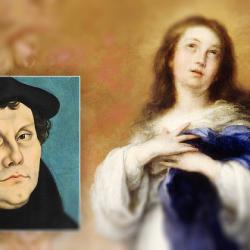
***
*****
*
It kind of bugs me. Why did the Church have to announce those dogmas in the 1800s anyway? I’ve read that previous clarifications are in response to heresy.
Exactly. The Church defined them at the highest dogmatic levels, because we Catholics believe that God is working in His Church, and that we can think and reflect upon things for centuries (development of doctrine) before making them absolutely binding on the faithful. It is deemed an “opportune” time to define, due to historical circumstances.
Example: The Trinity needed clarification due to the Arian heresy. Well, what kind of heresy was so prominent in the 1800s, anyway, that the Catholic church felt so obliged that it had to pronounce Mary as Immaculate and also her Assumption?
Well, theological liberalism was running rampant for a couple of generations. The Immaculate Conception (as with all Marian dogmas) safeguarded the deity of Christ, which was under attack. Jesus was so special that even His mother had to be given a special grace of sinlessness to bear Him.
Catholic convert Louis Bouyer gives another rationale:
If there is any Catholic belief that shows how much the Church believes in the sovereignty of grace, in its most gratuitous form, it is this one. It is remarkable that the Orthodox controversialists, contrary to the Protestants, reproach Catholics for admitting, in this one case of Our Lady, something analogous to what strict Calvinists admit for all the elect – a grace that saves us absolutely independently of us, not only without any merit of our own, but without any possibility of our cooperation, . . . whereas the Protestant view seems, not merely against reason, but completely absurd. To say that Mary is holy, with a super-eminent holiness, in virtue of a divine intervention previous to the first instant of her existence, is to affirm in her case as absolutely as possible that salvation is a grace, and purely a grace, of God.
(The Spirit and Forms of Protestantism, translated by A. V. Littledale, London: Harvill Press, 1956, p. 247)
The New Testament regards the resurrection of Our Lord not as an isolated event with only isolated repercussions for mankind, but as the beginning of the universal resurrection of the dead [see 1 Cor 15:13,16] . . . Resurrection, we must say again, is communal . . .
The heart of the doctrine of the resurrection is this sense of the communal, inclusive body of glory. Now I believe that it is precisely this sense of ‘resurrection-relatedness’ that is the foundation of the doctrine of the Assumption of Our Blessed Lady . . . while the victory over death that has taken place in Mary may not be general, there is an important sense in which it can be said to be thoroughly ‘normal’, a direct upshot and fruit of Christ’s own victory over sin and death . . .
It is precisely the typological role of the Assumption, its prefiguring of the general resurrection, which we find most consistently stressed in our earliest witnesses . . . The resurrection of Jesus is not simply typological but effective; it has a causal and not simply iconic relation to the general resurrection. It does not simply prefigure the reassembly of all men but actually sets it in motion. Now Our Lady receives resurrection as we all shall through the power of God; the difference in her case being only its anticipation, its role as sign and type . . .
Pope Pius saw that the Assumption struck a prophetic blow against the institutionalized individualism of the modern world, its competitive and alienated spirit, demonstrated in a global way in the Second World War, which had ended only five years before, and daily seen in men’s lives. A dogma that is based on an indestructible relationship of Mother and Son, and of the Son with humanity, has much to offer the world . . .
(in Alberic Stacpoole, editor, Mary’s Place in Christian Dialogue, Wilton, Conn.: Morehouse-Barlow, 1982, 113-116, 120, 109, 121)
Actually, I don’t have that much of a problem with [the] concept of these actual doctrines, except that it’s hard for me to fully believe that which I can not see in the Scriptures. This of course goes back again to me fully trusting the Church and it’s teaching authority, and not just the authority of Scripture.
I think it is pretty straightforward, and related to the general resurrection. I wrote in my book, A Biblical Defense of Catholicism:
Lest one think that a bodily ascent to heaven (of a creature, as opposed to Jesus) is impossible and “biblically unthinkable,” Holy Scripture contains the examples of Enoch (Hebrews 11:5; cf. Genesis 5:24), Elijah (2 Kings 2:1,11), St. Paul’s being caught up to the third heaven (2 Corinthians 12:2-4), possibly bodily, and events during the Second Coming (1 Thessalonians 4:15-17), believed by many evangelicals to constitute the “Rapture,” an additional return of Christ for believers only. All these occur by virtue of the power of God, not the intrinsic ability of the persons.
The Assumption of the Blessed Virgin flows of necessity from the Immaculate Conception and Mary’s actual sinlessness. Bodily death and decay are the result of sin and the Fall (Genesis 3:19, Psalm 16:10). Thus, the absence of actual and original sin “breaks the chain” and allows for instant bodily resurrection and also immortality, just as God intended for all human beings.
. . . Jesus’ Resurrection brings forth the possibility of universal resurrection (1 Corinthians 15:13,16), which is why He is called the “first fruits” (1 Corinthians 15:20-23). Mary’s Assumption is the “first fruits,” sign, and type of the general resurrection of all mankind, so that she represents the age to come, in which death and sin will be conquered once and for all (1 Corinthians 15:26). The Assumption is, therefore, directly the result of Christ’s own victory over sin and death. It, too, has a Christocentric meaning, in the same way as the Immaculate Conception and the designation Theotokos.
(pp. 190-191)
Another example of a biblical “assumption” is that of the Two Witnesses in Revelation:
Revelation 11:11-12: But after the three and a half days a breath of life from God entered them, and they stood up on their feet, and great fear fell on those who saw them. Then they heard a loud voice from heaven saying to them, “Come up hither!” And in the sight of their foes they went up to heaven in a cloud.
The Assumption is not explicitly stated, but is not contrary to anything in Scripture. Her sinlessness is expressly stated in Luke 1:28 (“full of grace”).
Beyond that, I question the Protestant premise that all doctrines must be explicitly laid out in Scripture. The Bible itself doesn’t ever teach that. Thus, we Catholics hold that doctrines have to be perfectly consistent with Scripture; in harmony with it, but not necessarily explicitly expressed.
For much more on this aspect, see scores of articles on my Bible and Tradition web page, and much more about Catholic Mariology and especially its harmony with the Bible basis on my Blessed Virgin Mary page.













